Human Resource Management: Exploring Dismissals and Redundancy
VerifiedAdded on 2020/03/16
|7
|1269
|133
Report
AI Summary
This report delves into the intricacies of human resource management, specifically focusing on the concepts of unfair and fair dismissals. It elucidates the circumstances under which dismissals are deemed unjust, such as those related to pregnancy, family responsibilities, trade union membership, and adherence to working hour regulations. Conversely, it outlines the grounds for fair dismissals, including employee conduct, qualifications, and redundancy. The report provides a detailed explanation of redundancy, emphasizing that it is a job, not a person, that becomes redundant due to factors like technological advancements, cost-cutting measures, or business closures. Furthermore, it examines the relevant ACAS codes of practice, particularly those concerning redundancy and consultation, and underscores the importance of consultation in fostering cooperation and reducing uncertainties. The report also covers the consultation period length, individual consultation requirements, selection criteria, disclosure obligations, and support for employees affected by redundancy, offering valuable insights into effective HRM practices.
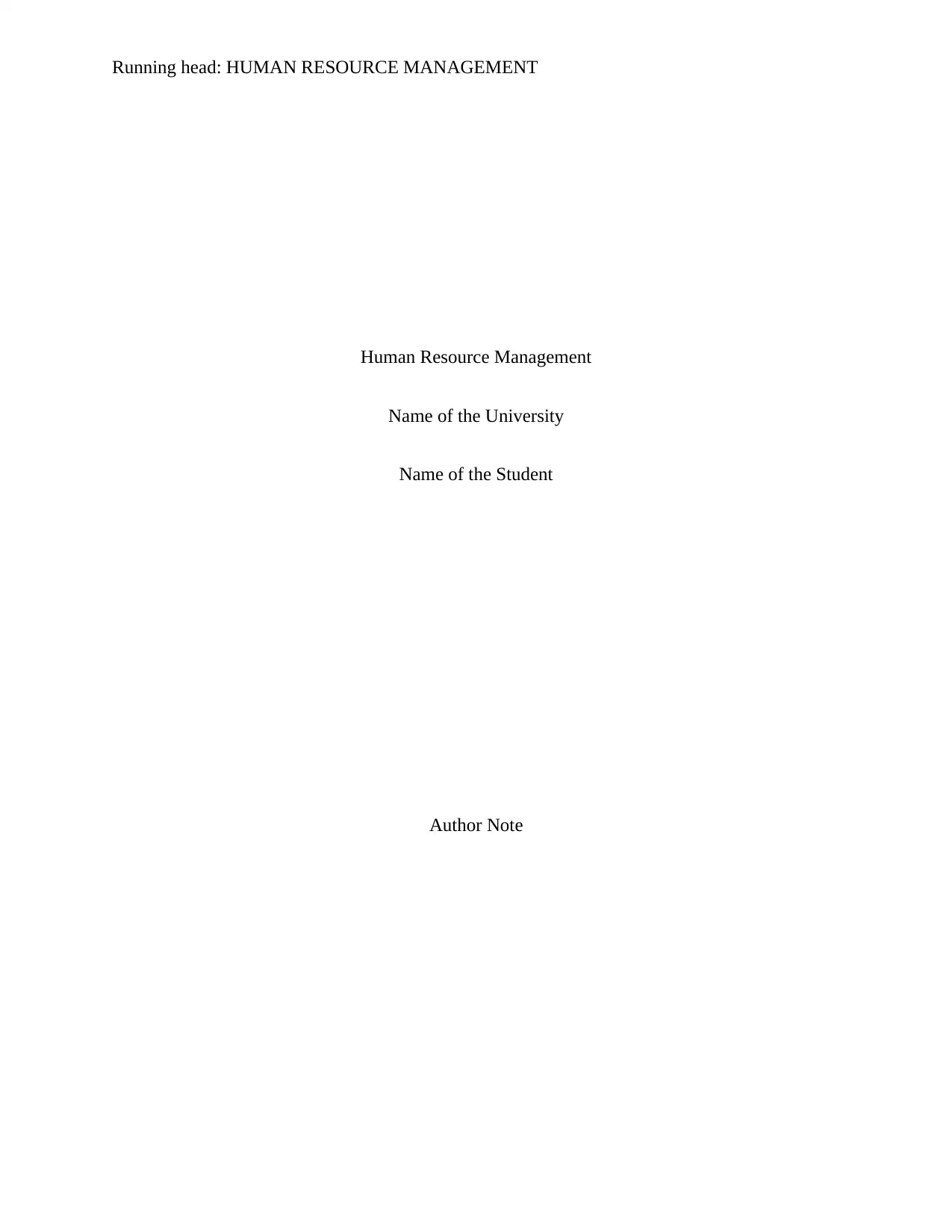
Running head: HUMAN RESOURCE MANAGEMENT
Human Resource Management
Name of the University
Name of the Student
Author Note
Human Resource Management
Name of the University
Name of the Student
Author Note
Paraphrase This Document
Need a fresh take? Get an instant paraphrase of this document with our AI Paraphraser
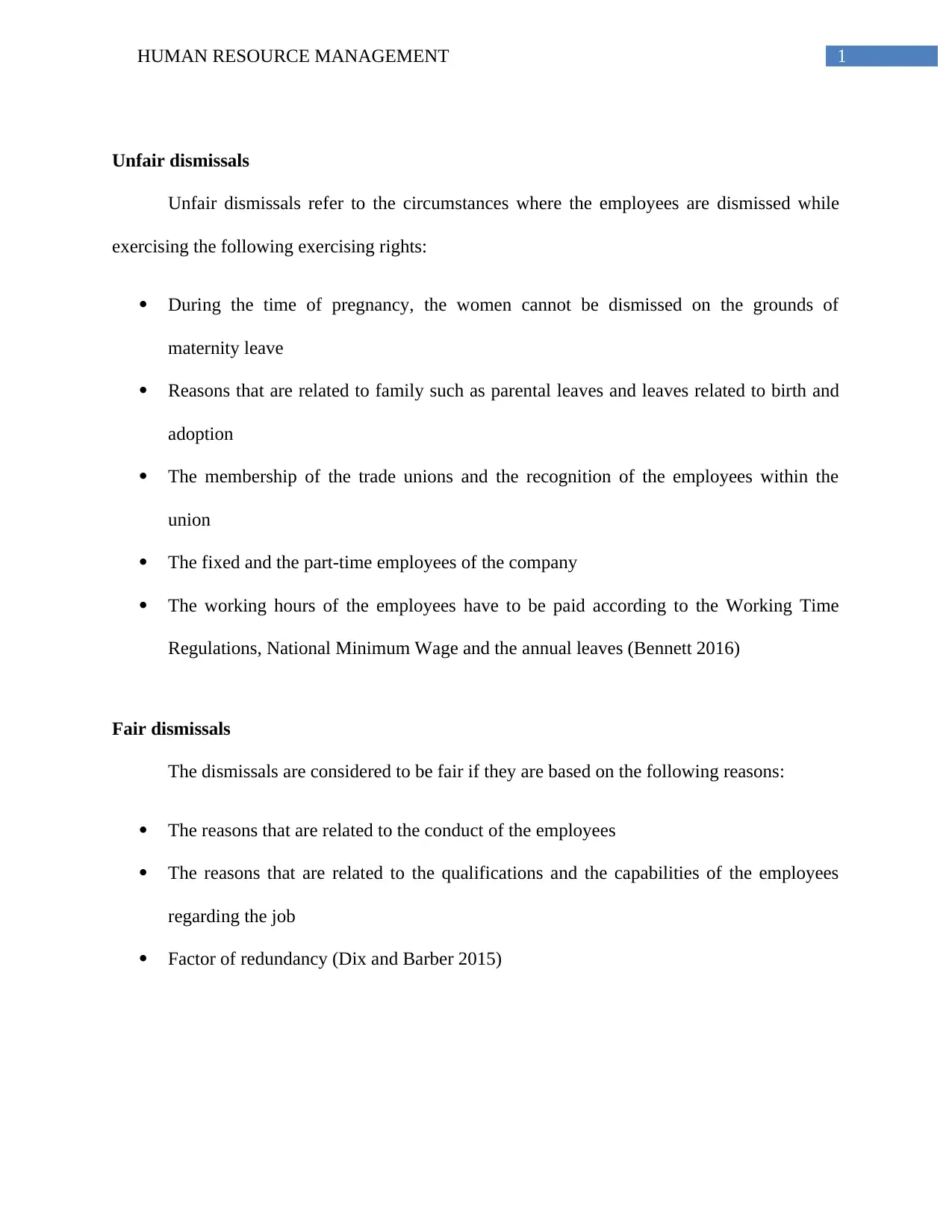
1HUMAN RESOURCE MANAGEMENT
Unfair dismissals
Unfair dismissals refer to the circumstances where the employees are dismissed while
exercising the following exercising rights:
During the time of pregnancy, the women cannot be dismissed on the grounds of
maternity leave
Reasons that are related to family such as parental leaves and leaves related to birth and
adoption
The membership of the trade unions and the recognition of the employees within the
union
The fixed and the part-time employees of the company
The working hours of the employees have to be paid according to the Working Time
Regulations, National Minimum Wage and the annual leaves (Bennett 2016)
Fair dismissals
The dismissals are considered to be fair if they are based on the following reasons:
The reasons that are related to the conduct of the employees
The reasons that are related to the qualifications and the capabilities of the employees
regarding the job
Factor of redundancy (Dix and Barber 2015)
Unfair dismissals
Unfair dismissals refer to the circumstances where the employees are dismissed while
exercising the following exercising rights:
During the time of pregnancy, the women cannot be dismissed on the grounds of
maternity leave
Reasons that are related to family such as parental leaves and leaves related to birth and
adoption
The membership of the trade unions and the recognition of the employees within the
union
The fixed and the part-time employees of the company
The working hours of the employees have to be paid according to the Working Time
Regulations, National Minimum Wage and the annual leaves (Bennett 2016)
Fair dismissals
The dismissals are considered to be fair if they are based on the following reasons:
The reasons that are related to the conduct of the employees
The reasons that are related to the qualifications and the capabilities of the employees
regarding the job
Factor of redundancy (Dix and Barber 2015)
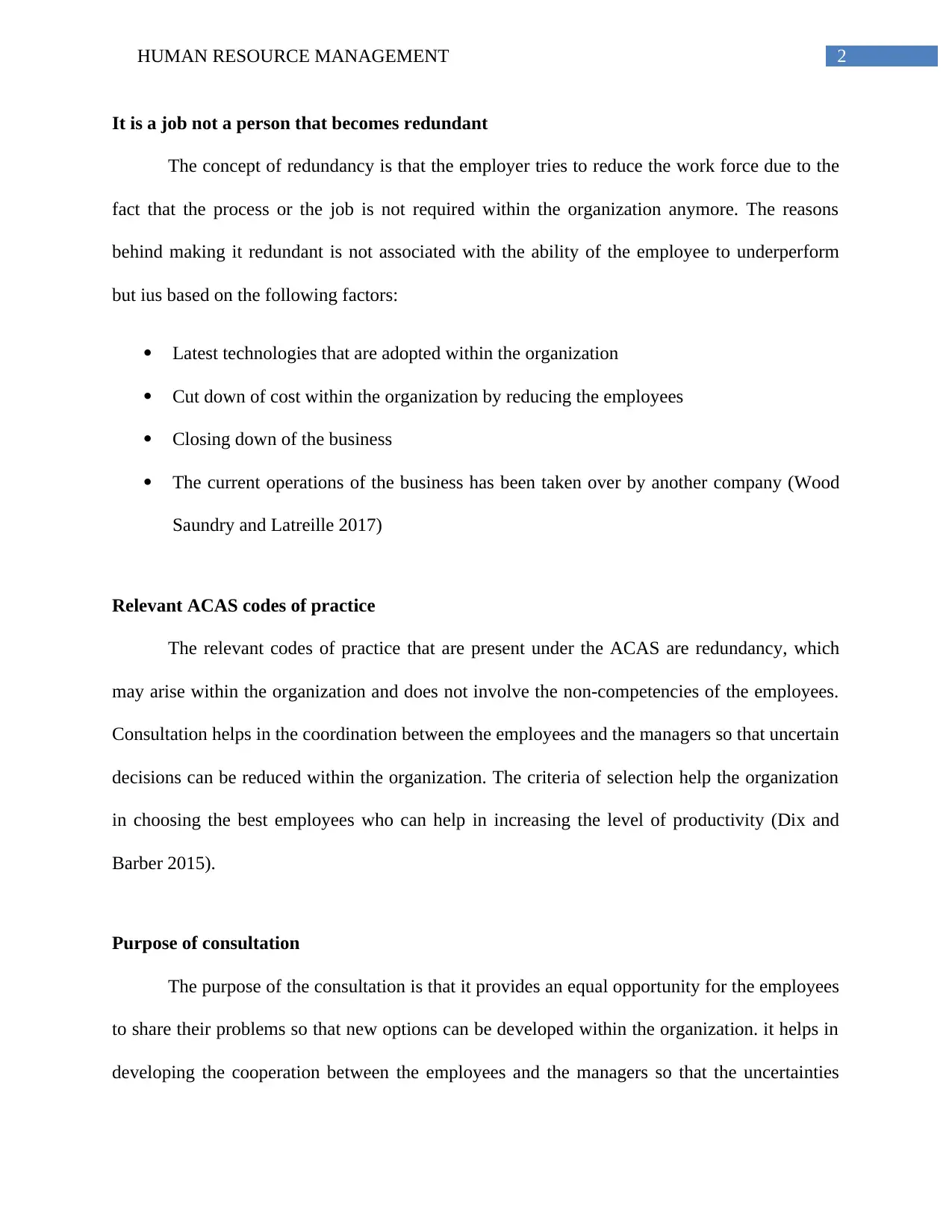
2HUMAN RESOURCE MANAGEMENT
It is a job not a person that becomes redundant
The concept of redundancy is that the employer tries to reduce the work force due to the
fact that the process or the job is not required within the organization anymore. The reasons
behind making it redundant is not associated with the ability of the employee to underperform
but ius based on the following factors:
Latest technologies that are adopted within the organization
Cut down of cost within the organization by reducing the employees
Closing down of the business
The current operations of the business has been taken over by another company (Wood
Saundry and Latreille 2017)
Relevant ACAS codes of practice
The relevant codes of practice that are present under the ACAS are redundancy, which
may arise within the organization and does not involve the non-competencies of the employees.
Consultation helps in the coordination between the employees and the managers so that uncertain
decisions can be reduced within the organization. The criteria of selection help the organization
in choosing the best employees who can help in increasing the level of productivity (Dix and
Barber 2015).
Purpose of consultation
The purpose of the consultation is that it provides an equal opportunity for the employees
to share their problems so that new options can be developed within the organization. it helps in
developing the cooperation between the employees and the managers so that the uncertainties
It is a job not a person that becomes redundant
The concept of redundancy is that the employer tries to reduce the work force due to the
fact that the process or the job is not required within the organization anymore. The reasons
behind making it redundant is not associated with the ability of the employee to underperform
but ius based on the following factors:
Latest technologies that are adopted within the organization
Cut down of cost within the organization by reducing the employees
Closing down of the business
The current operations of the business has been taken over by another company (Wood
Saundry and Latreille 2017)
Relevant ACAS codes of practice
The relevant codes of practice that are present under the ACAS are redundancy, which
may arise within the organization and does not involve the non-competencies of the employees.
Consultation helps in the coordination between the employees and the managers so that uncertain
decisions can be reduced within the organization. The criteria of selection help the organization
in choosing the best employees who can help in increasing the level of productivity (Dix and
Barber 2015).
Purpose of consultation
The purpose of the consultation is that it provides an equal opportunity for the employees
to share their problems so that new options can be developed within the organization. it helps in
developing the cooperation between the employees and the managers so that the uncertainties
⊘ This is a preview!⊘
Do you want full access?
Subscribe today to unlock all pages.

Trusted by 1+ million students worldwide
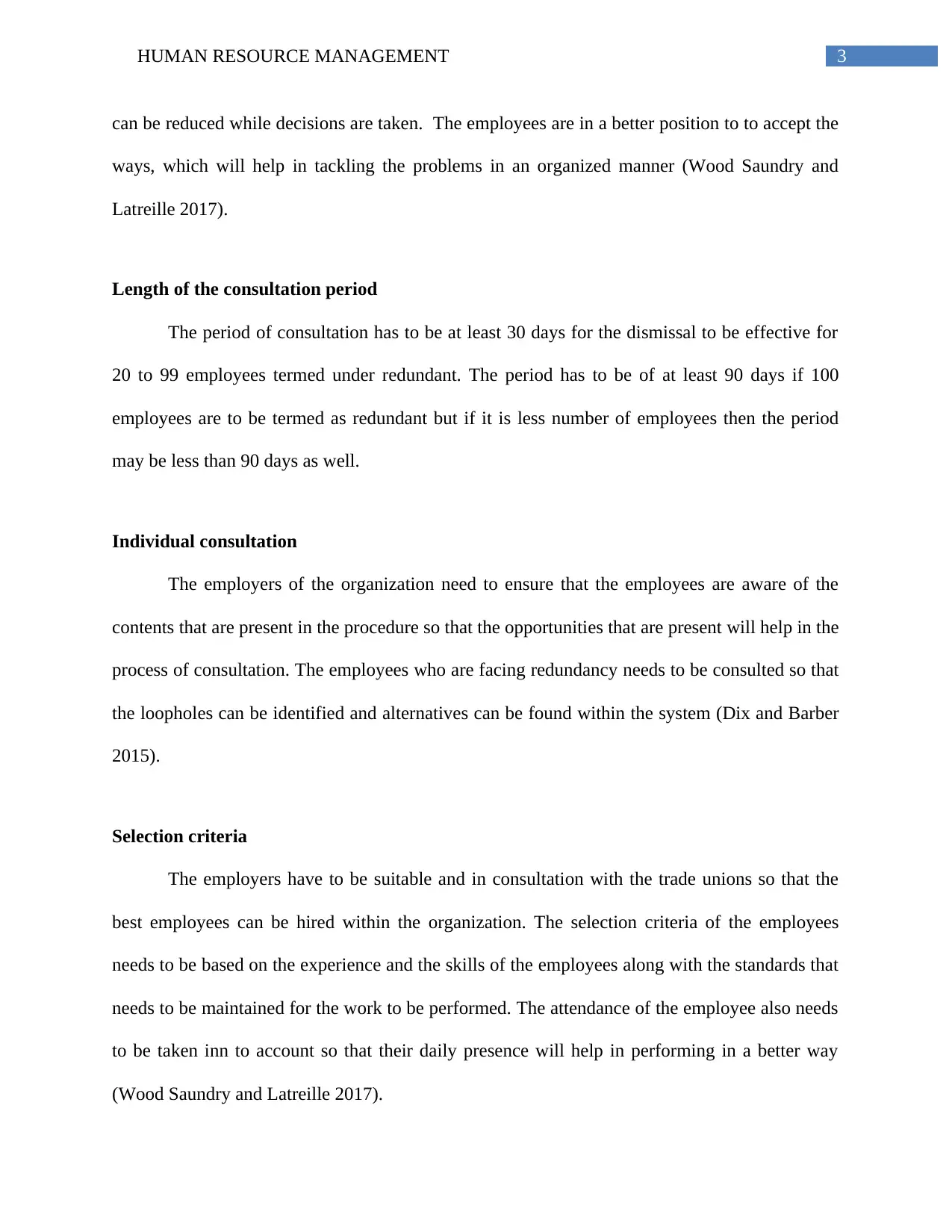
3HUMAN RESOURCE MANAGEMENT
can be reduced while decisions are taken. The employees are in a better position to to accept the
ways, which will help in tackling the problems in an organized manner (Wood Saundry and
Latreille 2017).
Length of the consultation period
The period of consultation has to be at least 30 days for the dismissal to be effective for
20 to 99 employees termed under redundant. The period has to be of at least 90 days if 100
employees are to be termed as redundant but if it is less number of employees then the period
may be less than 90 days as well.
Individual consultation
The employers of the organization need to ensure that the employees are aware of the
contents that are present in the procedure so that the opportunities that are present will help in the
process of consultation. The employees who are facing redundancy needs to be consulted so that
the loopholes can be identified and alternatives can be found within the system (Dix and Barber
2015).
Selection criteria
The employers have to be suitable and in consultation with the trade unions so that the
best employees can be hired within the organization. The selection criteria of the employees
needs to be based on the experience and the skills of the employees along with the standards that
needs to be maintained for the work to be performed. The attendance of the employee also needs
to be taken inn to account so that their daily presence will help in performing in a better way
(Wood Saundry and Latreille 2017).
can be reduced while decisions are taken. The employees are in a better position to to accept the
ways, which will help in tackling the problems in an organized manner (Wood Saundry and
Latreille 2017).
Length of the consultation period
The period of consultation has to be at least 30 days for the dismissal to be effective for
20 to 99 employees termed under redundant. The period has to be of at least 90 days if 100
employees are to be termed as redundant but if it is less number of employees then the period
may be less than 90 days as well.
Individual consultation
The employers of the organization need to ensure that the employees are aware of the
contents that are present in the procedure so that the opportunities that are present will help in the
process of consultation. The employees who are facing redundancy needs to be consulted so that
the loopholes can be identified and alternatives can be found within the system (Dix and Barber
2015).
Selection criteria
The employers have to be suitable and in consultation with the trade unions so that the
best employees can be hired within the organization. The selection criteria of the employees
needs to be based on the experience and the skills of the employees along with the standards that
needs to be maintained for the work to be performed. The attendance of the employee also needs
to be taken inn to account so that their daily presence will help in performing in a better way
(Wood Saundry and Latreille 2017).
Paraphrase This Document
Need a fresh take? Get an instant paraphrase of this document with our AI Paraphraser
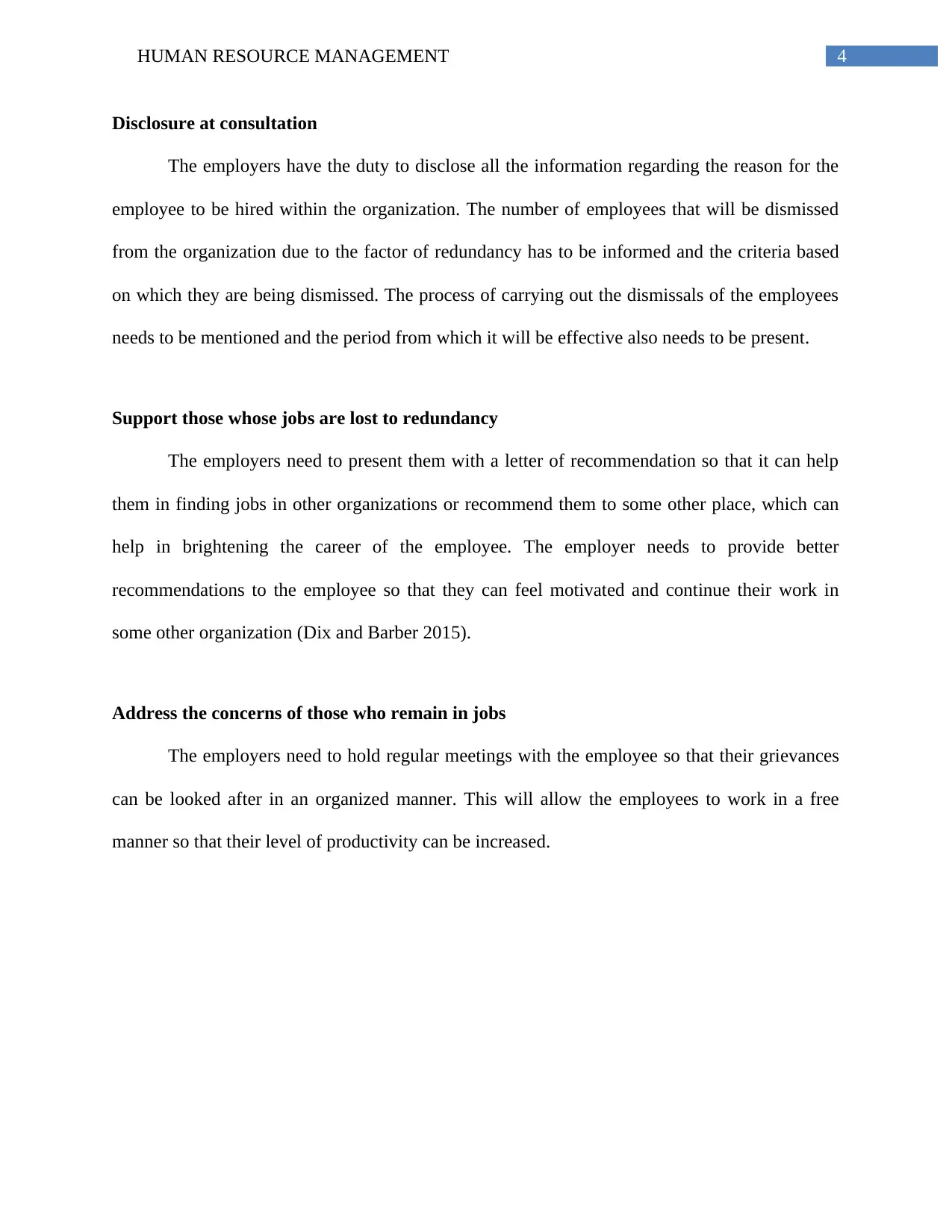
4HUMAN RESOURCE MANAGEMENT
Disclosure at consultation
The employers have the duty to disclose all the information regarding the reason for the
employee to be hired within the organization. The number of employees that will be dismissed
from the organization due to the factor of redundancy has to be informed and the criteria based
on which they are being dismissed. The process of carrying out the dismissals of the employees
needs to be mentioned and the period from which it will be effective also needs to be present.
Support those whose jobs are lost to redundancy
The employers need to present them with a letter of recommendation so that it can help
them in finding jobs in other organizations or recommend them to some other place, which can
help in brightening the career of the employee. The employer needs to provide better
recommendations to the employee so that they can feel motivated and continue their work in
some other organization (Dix and Barber 2015).
Address the concerns of those who remain in jobs
The employers need to hold regular meetings with the employee so that their grievances
can be looked after in an organized manner. This will allow the employees to work in a free
manner so that their level of productivity can be increased.
Disclosure at consultation
The employers have the duty to disclose all the information regarding the reason for the
employee to be hired within the organization. The number of employees that will be dismissed
from the organization due to the factor of redundancy has to be informed and the criteria based
on which they are being dismissed. The process of carrying out the dismissals of the employees
needs to be mentioned and the period from which it will be effective also needs to be present.
Support those whose jobs are lost to redundancy
The employers need to present them with a letter of recommendation so that it can help
them in finding jobs in other organizations or recommend them to some other place, which can
help in brightening the career of the employee. The employer needs to provide better
recommendations to the employee so that they can feel motivated and continue their work in
some other organization (Dix and Barber 2015).
Address the concerns of those who remain in jobs
The employers need to hold regular meetings with the employee so that their grievances
can be looked after in an organized manner. This will allow the employees to work in a free
manner so that their level of productivity can be increased.
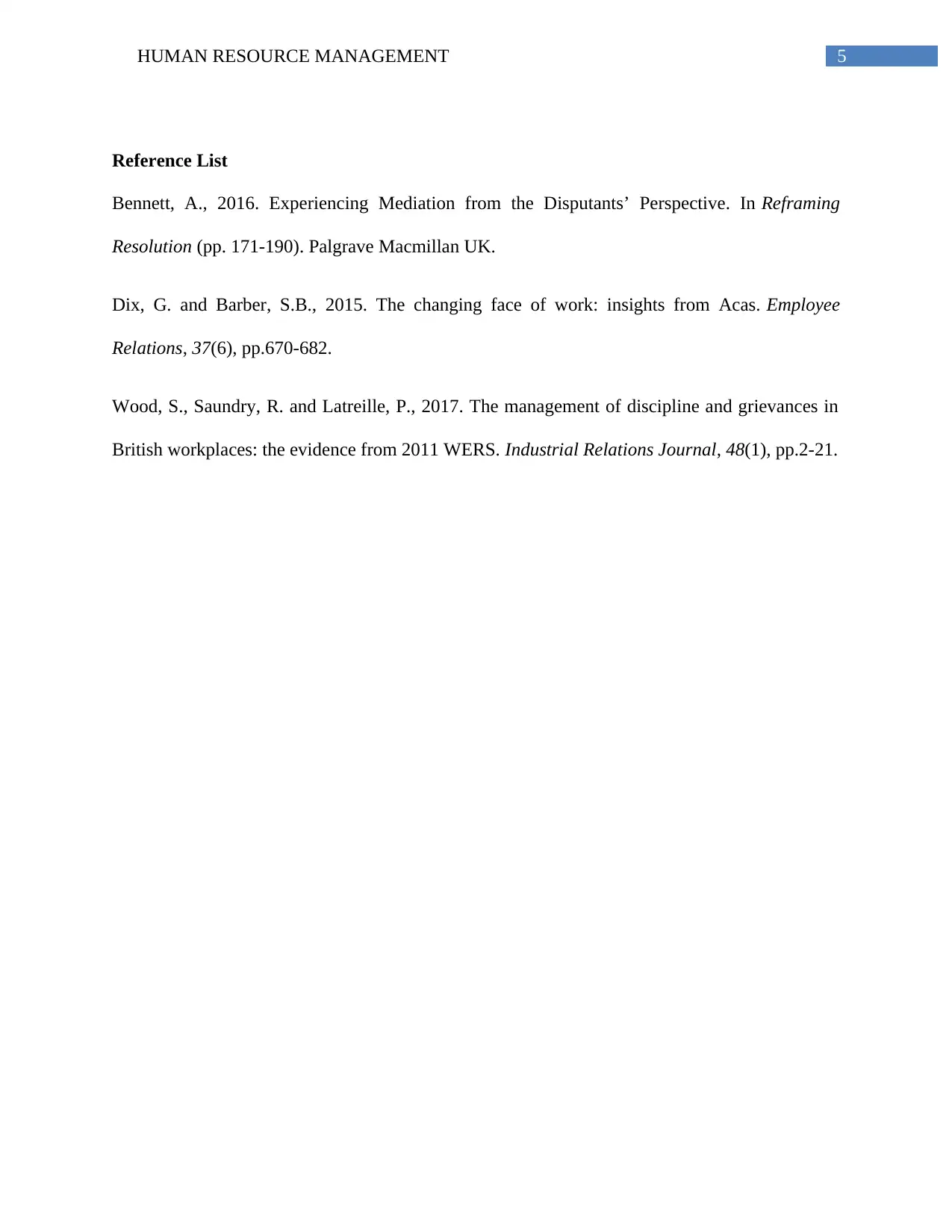
5HUMAN RESOURCE MANAGEMENT
Reference List
Bennett, A., 2016. Experiencing Mediation from the Disputants’ Perspective. In Reframing
Resolution (pp. 171-190). Palgrave Macmillan UK.
Dix, G. and Barber, S.B., 2015. The changing face of work: insights from Acas. Employee
Relations, 37(6), pp.670-682.
Wood, S., Saundry, R. and Latreille, P., 2017. The management of discipline and grievances in
British workplaces: the evidence from 2011 WERS. Industrial Relations Journal, 48(1), pp.2-21.
Reference List
Bennett, A., 2016. Experiencing Mediation from the Disputants’ Perspective. In Reframing
Resolution (pp. 171-190). Palgrave Macmillan UK.
Dix, G. and Barber, S.B., 2015. The changing face of work: insights from Acas. Employee
Relations, 37(6), pp.670-682.
Wood, S., Saundry, R. and Latreille, P., 2017. The management of discipline and grievances in
British workplaces: the evidence from 2011 WERS. Industrial Relations Journal, 48(1), pp.2-21.
⊘ This is a preview!⊘
Do you want full access?
Subscribe today to unlock all pages.

Trusted by 1+ million students worldwide
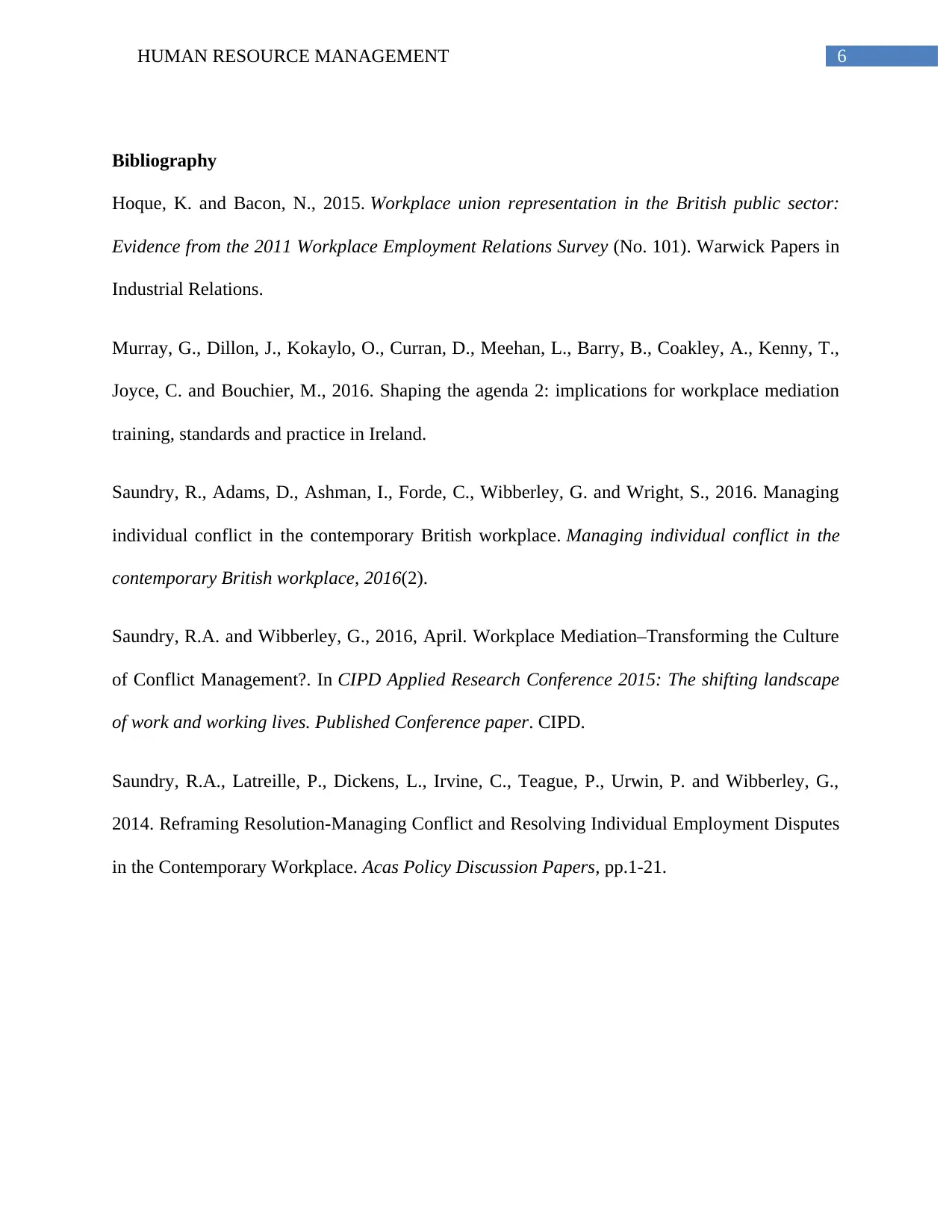
6HUMAN RESOURCE MANAGEMENT
Bibliography
Hoque, K. and Bacon, N., 2015. Workplace union representation in the British public sector:
Evidence from the 2011 Workplace Employment Relations Survey (No. 101). Warwick Papers in
Industrial Relations.
Murray, G., Dillon, J., Kokaylo, O., Curran, D., Meehan, L., Barry, B., Coakley, A., Kenny, T.,
Joyce, C. and Bouchier, M., 2016. Shaping the agenda 2: implications for workplace mediation
training, standards and practice in Ireland.
Saundry, R., Adams, D., Ashman, I., Forde, C., Wibberley, G. and Wright, S., 2016. Managing
individual conflict in the contemporary British workplace. Managing individual conflict in the
contemporary British workplace, 2016(2).
Saundry, R.A. and Wibberley, G., 2016, April. Workplace Mediation–Transforming the Culture
of Conflict Management?. In CIPD Applied Research Conference 2015: The shifting landscape
of work and working lives. Published Conference paper. CIPD.
Saundry, R.A., Latreille, P., Dickens, L., Irvine, C., Teague, P., Urwin, P. and Wibberley, G.,
2014. Reframing Resolution-Managing Conflict and Resolving Individual Employment Disputes
in the Contemporary Workplace. Acas Policy Discussion Papers, pp.1-21.
Bibliography
Hoque, K. and Bacon, N., 2015. Workplace union representation in the British public sector:
Evidence from the 2011 Workplace Employment Relations Survey (No. 101). Warwick Papers in
Industrial Relations.
Murray, G., Dillon, J., Kokaylo, O., Curran, D., Meehan, L., Barry, B., Coakley, A., Kenny, T.,
Joyce, C. and Bouchier, M., 2016. Shaping the agenda 2: implications for workplace mediation
training, standards and practice in Ireland.
Saundry, R., Adams, D., Ashman, I., Forde, C., Wibberley, G. and Wright, S., 2016. Managing
individual conflict in the contemporary British workplace. Managing individual conflict in the
contemporary British workplace, 2016(2).
Saundry, R.A. and Wibberley, G., 2016, April. Workplace Mediation–Transforming the Culture
of Conflict Management?. In CIPD Applied Research Conference 2015: The shifting landscape
of work and working lives. Published Conference paper. CIPD.
Saundry, R.A., Latreille, P., Dickens, L., Irvine, C., Teague, P., Urwin, P. and Wibberley, G.,
2014. Reframing Resolution-Managing Conflict and Resolving Individual Employment Disputes
in the Contemporary Workplace. Acas Policy Discussion Papers, pp.1-21.
1 out of 7
Related Documents
Your All-in-One AI-Powered Toolkit for Academic Success.
+13062052269
info@desklib.com
Available 24*7 on WhatsApp / Email
![[object Object]](/_next/static/media/star-bottom.7253800d.svg)
Unlock your academic potential
Copyright © 2020–2025 A2Z Services. All Rights Reserved. Developed and managed by ZUCOL.




